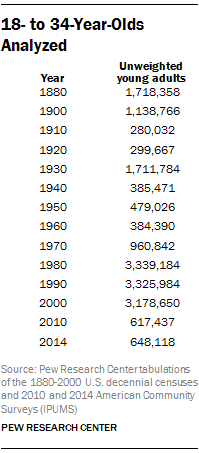The analysis is based on the 1880 to 2000 decennial censuses and the 2006 to 2014 American Community Survey (ACS). The Census Bureau began collecting the ACS in 2001 and in 2006 expanded its coverage to the entire residential population, thus making it comparable to the earlier censuses. The ACS was designed to collect detailed information matching that obtained in the long-form decennial census questionnaire (which was last collected in the 2000 Census). The decennial census and ACS microdata files developed by the University of Minnesota population center, or IPUMS files, were utilized. Documentation on the IPUMS version of the microdata files is at https://usa.ipums.org/usa/.
The ACS has three advantages over other data sources on the living arrangements of young adults. College students living in dormitories are classified as residing in group quarters and thus not considered to be residing in the home of their parent(s). The ACS does not overestimate the share of young adults living at home due to dormitory living.

Young adult living arrangements are based on the young adult’s relationship to the head of the household. The decennial census and ACS have collected information on the respondent’s relationship to the head in consistent fashion since the 1880 Census. Some of the detailed relationships to the head were not identified in early censuses, but the child of the head has always been identified. The share of young adults living in the home of their parent can be estimated consistently since 1880.
The sample census files made available to the public are large samples. At minimum the file is a 1% sample of the nation’s young adults. The smallest sample is the 1910 Census sample, a 1% sample file of the population. In spite of the total population being much smaller in 1910, the 1910 file has about 280,000 18- to 34-year-old unweighted respondents. The unweighted number of young adults analyzed is in the table to the right.
Young adults “living with a parent” are those who are the child of the head of the household.
In this report the four living arrangements are mutually exclusive. Young adults who are the child of the household head are assigned to the living with parent(s) category whether or not they have a partner. If they are married but living in the home of their parent(s), they are classified as living with parents. Young adults with a spouse or partner who establish their own household constitute the married/cohabiting head or partner category. Some married young adults reside in the home of a family member other than a parent (perhaps a sibling or aunt/uncle) or an unrelated person. In this instance both spouses are in the “other arrangements” category.
The census has consistently inquired as to marital status since 1880.
Information on cohabiting relationships is available only since 1990. Furthermore, the census and ACS do not capture all cohabiting relationships. Beginning with the 1990 Census, the responses on the relationship to the head of the household question distinguished unmarried partners from “housemate or roommate.” Only cohabiting relationships in which one of the partners is the head of the household can be identified. 22 The share of young adults who are married or cohabiting will be underestimated before 1990 because cohabiting relationships cannot easily be identified before 1990. The size of the underestimation before 1990 is uncertain because the prevalence of cohabitation before 1990 is not known. 23
The racial and ethnic categories reported are not consistent over time due to changes in the collection of racial and ethnic information since 1880. For example, information on Hispanic identity or origin was not collected from all respondents until 1980. Until 1910 the responses on the race question pertaining to Asian identity included only Chinese and Japanese. This report’s racial and ethnic categories used the IPUMS variable RACE and thus there is a break in the racial categories at 2000 due to the introduction of multiple race identification in the 2000 Census and ACS. 24




